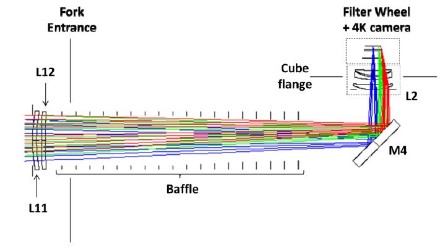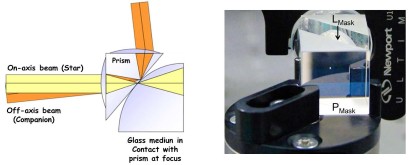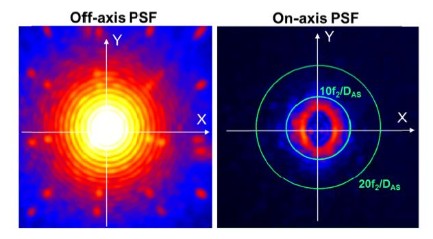Optical instrumentation for astronomy
Optical design is the process used to find the best set of lens construction parameters (radii of curvature, thicknesses, airspaces, and materials) that optimizes the overall performance (including the manufacturability) of an optical system.
We have developed a strong expertise from the theory of optical aberrations to the simulations using Zemax Optics Studio through many projects, mainly in connection with astronomy and aerospace.
Examples of optical systems we designed are given below.
* Focal reducer of the Thai National Telescope (TNT)
We collaborate with the National Astronomical Research Institute of Thailand (NARIT) since 2014. The focal reducer is specified to image the TNT specified Field Of View (FOV), a 15 arcminute diameter circle, on a camera with a pixel scale equal to 0.42 arcsecond/pixel and a spatial resolution better than 1.2 arcsecond, over the spectral band V, B, R and I of the Johnson-Cousins photometric system. This focal reducer comprises a doublet located at the fork mount and a triplet placed in front of the camera. The optical and mechanical design activities as well as the manufacturing of most of the mechanical parts have all been conducted at NARIT. Lenses have been made by Optimax (USA). The commissioning of the instrument is planned for the beginning of the 2018-2019 observing season with the aim to verify all the performance of the instrument in operational conditions.

C. Buisset, A. Deboos, T. Lépine, S. Poshyachinda, and B.r Soonthornthum, Design and performance estimate of a focal reducer for the 2.3 m Thai National Telescope, Opt. Express 24, 1416-1430 (2016)
* EvWaCo
We are developing in collaboration with NARIT and the Université de Nice Côte-d’Azur a new kind of coronagraph, called the “Evanescent Wave Coronagraph” (EvWaCo). This instrument will be dedicated to the observation and the characterization of stellar close environments and faint companions with ground-based and space-based telescopes. The concept of EvWaCo consists of using the Frustration of the Total Internal Reflection (FTIR) to produce the coronagraphic effect.
The main advantage with respect to other coronagraphs is that: i) this instrument is partially achromatic and ii) the star light can be collected for example to install a wavefront sensor to compensate for the wavefront errors caused by the high spatial frequencies distortions. This instrument provides a contrast of a few 10^-6 at a distance comprised between 10 and 20 Airy radii from the axis, in polychromatic and unpolarized light at the wavelengths equal to 780 nm and 880 nm respectively. Next year, we plan to install a simulator of turbulence and an adaptive optics setup to measure deep contrasts performance while observing through a turbulent optical medium. We assess that these developments will cover a time period equal to 3 years and that this prototype should be commissioned on the TNT at the horizon 2020.


C. Buisset, Y. Rabbia, T. Lepine, M.A. Alagao, E. Ducrot, S. Poshyachinda, and B. Soonthornthum, Study of a coronagraphic mask using evanescent waves, Opt. Express 25, 7273-7287 (2017)
* Hypertelescope
We collaborate since 2014 with the team of Pr Labeyrie (Collège de France), on the developpement of hypertelescopes.
The hypertelescope can be described as a large multi-aperture Fizeau interferometer, equipped with a small pupil-densifier array of miniature Galilean telescopes which is inserted in a relayed pupil plane after the Fizeau focal plane. This concentrates most of the collected energy in the interference peak, thus greatly increasing its intensity but reducing the size of the directly imageable field.
We are involved in theoretical modeling (Fourier Optics) and numerical simulations with Zemax (choice of aperture pattern and meta-mirror shape, pupil drift effect, reduction of optical aberrations…).

E. Bondoux et al, Optical design options for hypertelescopes and prototype testing, Optical and Infrared Interferometry and Imaging V, edited by F. Malbet, M. J. Creech-Eakman, P. G. Tuthill, Proc. of SPIE Vol. 9907, 99071J, 2016
L. Dettwiller and T. Lépine, Stellar interferometers and hypertelescopes: new insights on an angular spatial frequency approach to their non-invariant imaging, Accepted in july 2017 for publication in Monthly News of the Royal astronomical Society
